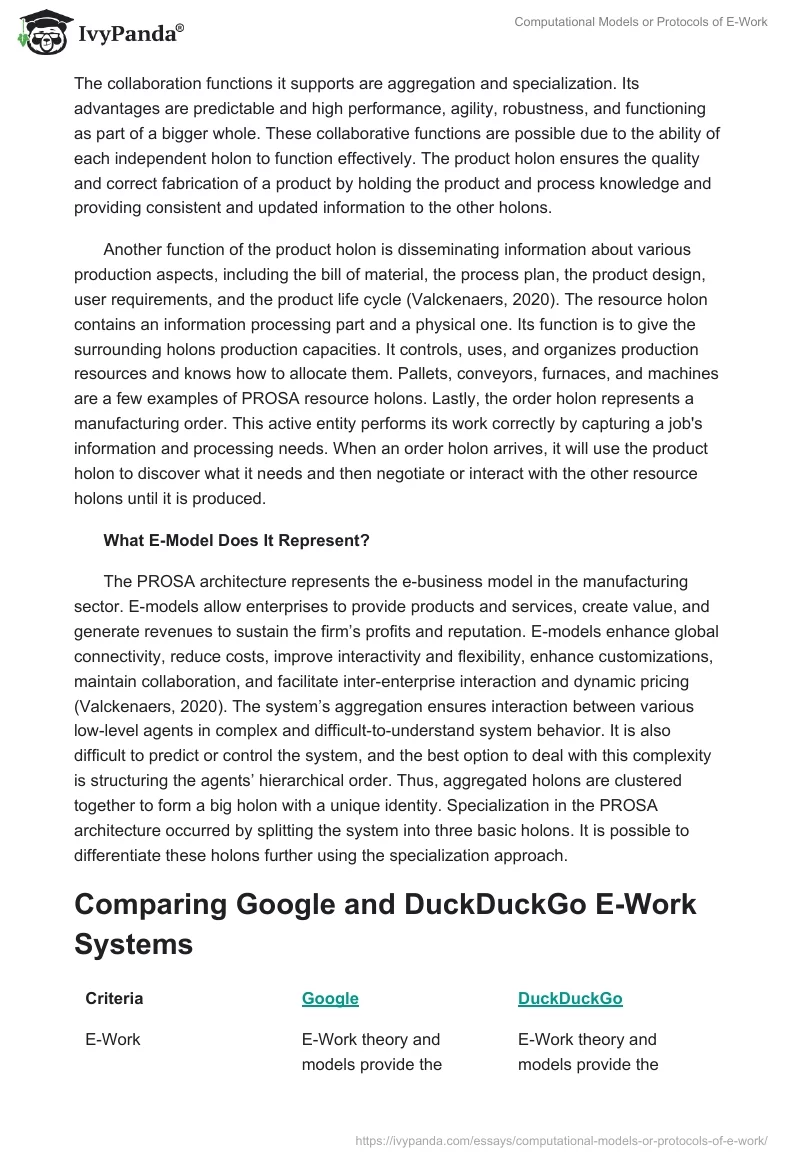E-Work System: The PROSA Holonic Manufacturing System
What Kind of E-Business or E-Service Does It Represent?
Collaborative e-work systems are the result of computing and computational developments in the 1990s and represent technological changes and improvements over the years. One of these systems is the Product-Resource-Order-Staff Architecture (PROSA) – a reference architecture for holonic manufacturing. The system is developed at PMA-KULeuven and represents a versatile e-business system (Valckenaers, 2020).
Holonic manufacturing is a highly distributed control paradigm, with its “holons” serving as independent cooperating agents. The PROSA architecture contains three basic holons, including order, product, and resource holons (Valckenaers, 2020). Engineers use the object-oriented concepts of specialization and aggregation to structure these three basic holons. If the system requires expert knowledge, engineers can add staff holons to help with it.
Since the result has significant self-similarity, the new component integration complexity is significantly low. The elevated level of self-similarity also simplifies system reconfiguration. PROSA covers heterarchical and hierarchical control approaches. Being a generalization of these two methodologies, PROSA introduces significant innovations. For example, it decouples the system structure from the control algorithm and separates logistical aspects from technical ones. PROSA also allows for exploration that could lead to advanced hybrid control algorithms.
What Collaboration Functions Does It Support?
PROSA supports various collaborative functions through its basic holons and architectural style. It makes significant contributions to control system responsiveness by combining the advantages of heterarchical and hierarchical architectural styles. This combination of two approaches facilitates a more effective handling of each methodology’s disadvantages if used individually or separately (Valckenaers, 2020).
The collaboration functions it supports are aggregation and specialization. Its advantages are predictable and high performance, agility, robustness, and functioning as part of a bigger whole. These collaborative functions are possible due to the ability of each independent holon to function effectively. The product holon ensures the quality and correct fabrication of a product by holding the product and process knowledge and providing consistent and updated information to the other holons.
Another function of the product holon is disseminating information about various production aspects, including the bill of material, the process plan, the product design, user requirements, and the product life cycle (Valckenaers, 2020). The resource holon contains an information processing part and a physical one. Its function is to give the surrounding holons production capacities. It controls, uses, and organizes production resources and knows how to allocate them. Pallets, conveyors, furnaces, and machines are a few examples of PROSA resource holons.
Lastly, the order holon represents a manufacturing order. This active entity performs its work correctly by capturing a job’s information and processing needs. When an order holon arrives, it will use the product holon to discover what it needs and then negotiate or interact with the other resource holons until it is produced.
What E-Model Does It Represent?
The PROSA architecture represents the e-business model in the manufacturing sector. E-models allow enterprises to provide products and services, create value, and generate revenues to sustain the firm’s profits and reputation. E-models enhance global connectivity, reduce costs, improve interactivity and flexibility, enhance customizations, maintain collaboration, and facilitate inter-enterprise interaction and dynamic pricing (Valckenaers, 2020). The system’s aggregation ensures interaction between various low-level agents in complex and difficult-to-understand system behavior.
It is also difficult to predict or control the system, and the best option to deal with this complexity is structuring the agents’ hierarchical order. Thus, aggregated holons are clustered together to form a big holon with a unique identity. Specialization in the PROSA architecture occurred by splitting the system into three basic holons. It is possible to differentiate these holons further using the specialization approach.
Comparing Google and DuckDuckGo E-Work Systems
PROSA CCT Design Principles
The two collaborative control theory (CCT) principles underpinning PROSA’s designs are bio-inspired collaboration and learning, adaptation, and evolutionary collaboration. The former design principle is about designing agent-based collaboration and interaction models for e-work (Taha et al., 2021). The former is about appreciating learning and adaptive mechanisms from biological communities for the control and automation of e-work systems. The former design approach may be centralized or decentralized. In the PROSA system, these design approaches exist as aggregation and specialization. They ensure that the order, product, and resource holons work effectively.
Aggregation refers to a set of related holons structured so that they form a bigger holon with a unique identity. This structuring of the basic holons forms a hierarchy that is open-ended at the bottom and top – meaning it can resolve the complex, incomprehensible, unpredictable, and uncontrollable system behavior resulting from the interaction between various low-level agents (Nayyar et al., 2021). The aggregation hierarchy construes the image of a tree shape, but this is not always the case, as its holons may be connected to various components and tools.
Aggregated holons are also not static, as they change their content frequently depending on the system’s needs. Engineers design aggregated holons upfront, but some can form due to self-organizing holon interactions (Larsen et al., 2020). Specialization comes from object-oriented design methodologies, the first of which is the identification of three basic holons in the PROSA system. It is possible to still subdivide these three holons into smaller parts to remove abstractness about their location in the architecture.
Google and DuckDuckGo E-Criterion and E-Measure
The e-criterion is anchored in the emerging characteristics of e-work concepts, including innovation, internet-of-things, and systems of systems. It reflects SMART and tangible e-service, e-business, and e-work systems. This criterion is integrability – integrating distributed agent data to increase its usefulness (Hoxha et al., 2018). It has two dimensions, which include connectivity and behavioral patterns. The quality, level, and type of connectivity between the network and application layer and distributed operating systems influence performance.
Behavioral patterns refer to the system’s ability to share necessary information. E-measures address issues to eradicate failures and ensure success. For the selected pair, the e-measure is conflict and error detectability. Applying the e-measure and the e-criterion to the selected companies reveals that both institutions are still effective and reliable and compete on principle and effectiveness. Both Google and DuckDuckGo integrate distributed agent data, increase its usefulness, and detect conflict and error.
References
Hoxha, B., Dokhanchi, A., & Fainekos, G. (2018). Mining parametric temporal logic properties in model-based design for cyber-physical systems. International Journal on Software Tools for Technology Transfer, 20(1), 79-93.
Larsen, P. G., Macedo, H. D., Fitzgerald, J., Pfeifer, H., Benedikt, M., Tonetta, S.,… & Suciu Jr, G. (2020). A cloud-based collaboration platform for model-based design of cyber-physical systems.Electrical Engineering and Systems Science, 5(8).
Nayyar, A., Tanwar, S., & Abouhawwash, M. (2021). Emergence of Cyber Physical System and IoT in Smart Automation and Robotics: Computer Engineering in Automation. Springer.
Taha, W. M., Taha, A. E. M., & Thunberg, J. (2021). Cyber-Physical Systems: A Model-Based Approach. Springer Nature.
Valckenaers, P. (2020). Perspective on holonic manufacturing systems: PROSA becomes ARTI. Computers in Industry, 120, 103226.


